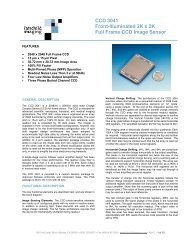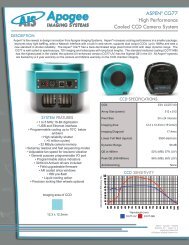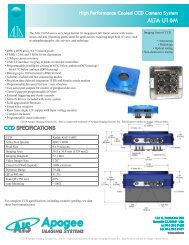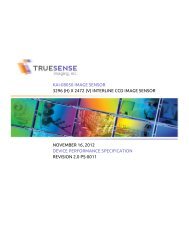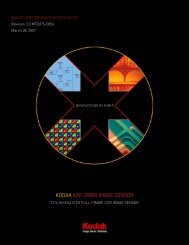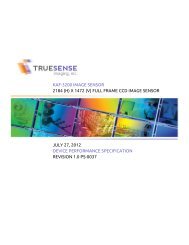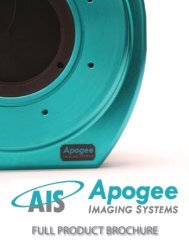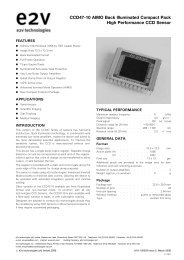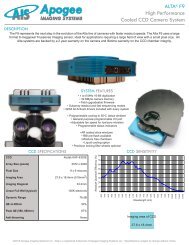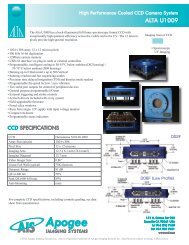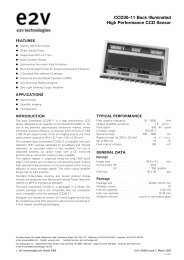OEM Support - Apogee Instruments, Inc.
OEM Support - Apogee Instruments, Inc.
OEM Support - Apogee Instruments, Inc.
You also want an ePaper? Increase the reach of your titles
YUMPU automatically turns print PDFs into web optimized ePapers that Google loves.
CCD SELECTION<br />
CCDs come in many shapes and sizes, as<br />
well as several different architectures.<br />
Some architectures were developed<br />
specifically to address the needs of extremely<br />
low light applications like astronomy (backilluminated<br />
CCDs). Other technologies<br />
can be adapted to astronomy with excellent<br />
results, but a bit more patience and diligence<br />
may be necessary (interline transfer CCDs).<br />
Here are some ideas to keep in mind:<br />
QUANTUM EFFICIENCY<br />
Higher sensitivity = higher quantum<br />
efficiency = shorter exposures to get the<br />
same results. Shorter exposures = more time<br />
for other exposures and less frustration with<br />
guiding and tracking. The peak value of a<br />
quantum effiiciency curve does not tell the<br />
full story of a CCD’s sensitivity. The area<br />
under the curve gives the true comparison of<br />
a CCD’s relative sensitivity. Twice the area<br />
under the curve = half the time making the<br />
exposure. Or, use the same exposure time,<br />
but get twice the signal. <strong>Apogee</strong> supports<br />
back-illuminated, front-illuminated, and<br />
interline transfer devices. Back-illuminated<br />
CCDs have the highest overall sensitivity.<br />
However, they are subject to etaloning (aka<br />
“fringing”) in the near-infrared. Frontilluminated<br />
CCDs are much less expensive<br />
than back-illuminated CCDs. Make your<br />
own choices regarding the Biggest Bang for<br />
the Buck.<br />
UV & NIR WAVELENGTHS<br />
Between 200-300 nm: E2V Back-illuminated<br />
UV enhanced CCDs<br />
Between 300-400 nm: most Kodak CCDs<br />
have zero QE at 300 nm, increasing linearly<br />
to >40% at 400 nm.<br />
Near Infrared: Back-illuminated CCDs have<br />
the highest QE, but they are also subject to<br />
fringing (also known as “etaloning”) with<br />
monochromatic NIR (simply put, the light<br />
bounces around inside the CCD itself). Some<br />
companies have developed proprietary versions<br />
of CCDs that minimize, though not<br />
eliminate, the effect by changing the thickness<br />
of the CCD itself.<br />
www.ccd.com<br />
PIXEL SIZE<br />
The smaller the pixel, the lower the signal<br />
that can be stored in the pixel (“full well<br />
capacity”). If the noise per pixel is the same<br />
for two cameras, lower full well means lower<br />
signal-to-noise, or compromised image<br />
quality. Such a compromise is hard to see<br />
when doing bright field imaging. But when<br />
doing low light imaging, higher signal to<br />
noise means pulling out those faint elements<br />
without making the bright areas into a burned<br />
white blob.<br />
In many cases, using a smaller pixel in<br />
order to obtain higher pixel resolution is<br />
actually dysfunctional. For example, in the<br />
field of microscopy, pixels smaller than 6<br />
microns do not provide additional spatial<br />
information. At only 4X magnification,<br />
with a numerical aperture of 0.1 and a<br />
wavelength of 550 nm (green), the limit to<br />
practical resolution is about a 3.65 micron<br />
feature. Such a feature maps to 14.6 microns<br />
on the CCD. Nyquist sampling requires<br />
oversampling by a factor of 2 in order to<br />
accurately reconstruct the signal. Thus, a<br />
7.3 micron pixel is small enough to gather<br />
all the spatial information provided by the<br />
microscope. As magnification is increased,<br />
the required size for the pixel also increases.<br />
Pixels in the range of 6 to 8 microns are<br />
the ideal match for microscopy, storing<br />
maximum signal without compromising<br />
spatial sampling.<br />
Image: Gary McAnally, <strong>Apogee</strong> Imaging<br />
Systems. Slide courtesy of Chroma.<br />
COLOR CCDS<br />
Color CCDs are convenient for one-shot<br />
color, but they compromise in several ways.<br />
First, the typical red-green-blue (RGB) Bayer<br />
pattern over the pixels of the CCD (see<br />
below) cannot be changed--you cannot do<br />
monochromatic imaging one day, RGB the<br />
next, and cyan-magenta-yellow (CMY) on<br />
the third. Second, color CCDs cannot deliver<br />
the full resolution of the imager. They can,<br />
however, deliver all three color channels at<br />
exactly the same instant in time.<br />
Typical RGB Bayer filter pattern designed to<br />
mimic the responsivity of the human eye.<br />
Quantum efficiency of the Kodak KAI-16000<br />
CCD: black line is monomchrome version;<br />
RGB lines are the color version.<br />
DYNAMIC RANGE<br />
Interline transfer CCDs have, at most, a<br />
full well capacity of about 50K electrons. If<br />
the electronics limits the read noise to 8-10<br />
electrons, this is a dynamic range of 50K/10<br />
= 5000:1, or about 12.3 bits. Most argue for<br />
oversampling by an extra bit, or some argue<br />
even two. However, a 16-bit analog-todigital<br />
(AtoD) converter does not upgrade a<br />
12 bit imager into a 16 bit imager. A Kodak<br />
KAF-1001E (Alta U6 camera), using the low<br />
noise (aka high gain) output amplifier, can be<br />
operated at 6 electrons noise with a full well<br />
of 200K electrons, or a dynamic range of<br />
more than 30K:1, about 15 bits.<br />
Specifications subject to change without notice.



